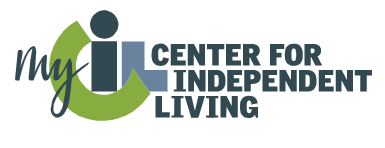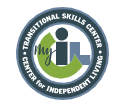Self-direction, sometimes called Consumer-direction or Participant-direction, gives you the freedom to choose the services and supports you need to live independently, in your own home.
When you’re self-directed, you can hire the caregivers you want. You decide the type of services you need. You determine the best schedule of care for you.
In short, self-direction allows you to design the supports that are best for you. You create a plan based on your challenges and strengths. With self-direction, you determine the supports that help you reach your unique independent living goals.
History of Self-Direction
Soon after the end of World War II, the Veterans Administration created a program in which Veterans with disabilities could use their government benefits to hire their own caregivers. The idea of giving cash for government benefits didn’t take hold in civilian programming until the mid-1990s.
That’s when The Robert Wood Johnson Foundation — working alongside the U.S. Department of Health and Human Services — awarded grants in 19 states to develop self-determination programs.
Participants of these programs managed their funding and directly controlled the caregivers who worked for them. These programs developed into Medicaid-funded programs we know today under the Home and Community-Based waiver program.
Self-Direction Success
Around the year 2000, self-direction became a key part of Home and Community-Based services thanks to the Cash and Counseling Demonstration and Evaluation (CCDE). This experiment reviewed over 6,500 Medicaid-eligible people with needs for long-term services and supports in 3 states who were self-directing. It compared these people to people in the traditional agency program.
The result showed those self-directing their supports and services had access to more services, were more satisfied with their services and enjoyed equally good or better health outcomes.
Self-Directed Services vs. Traditional Services
One of the best ways to explain self-direction is by comparing it to the traditional approach.
Self-directed services are different than traditional services in several key actions: choosing caregivers, determining the services, setting tasks, determining caregiver pay rates, training caregivers and setting the schedule.
Choosing Caregivers
In the traditional option, the agency you work with recruits the caregivers. Your choice is limited to the agency’s employed caregivers. You don’t have the option to choose someone you know and trust.
The other downside to agency caregivers is availability. There can be a shortage of caregivers, and turnover can be frequent. You are left having to work with new caregivers.
Freedom to Choose Who You Want
When you are self-directed, you have the freedom to choose your caregivers. Whether you choose a trusted neighbor, friend or loved one, you become their Employer. You also choose reliable backup caregivers who can fill your shifts in a pinch.
Having someone you know and trust come into your own home and perform tasks that may be very personal can ease your mind. You will feel more comfortable and safer.
Determining the Services
Case managers determine the services a client needs in the traditional program. You have little input into these decisions, if any.
On the other hand, with self-direction, you and your case manager define your needs. You work together to determine the services that will address your unique challenges and goals.
Setting Tasks
When you are in a traditional approach, the agency and program set your caregivers’ tasks. Agencies must be very specific about the tasks a caregiver can perform due to liability reasons. For example, if you need your window shade drawn that requires standing on a stool, your agency caregiver may not be allowed to perform that task.
Do you need light housekeeping? Do you need help getting showered and dressed? Do you need assistance with your medications? In the self-direction program, you identify the tasks you need your caregiver to perform. You determine the help you need to live your best, independent life — in your own home and community.
Determining Caregiver Pay Rates
Clients in a traditional program have no say in their caregivers’ pay rates — the agency sets the pay rates. Often, the rates they pay are lower than the rates of the self-directed option. With the lower pay rates, it is harder to find and maintain qualified caregivers.
As a self-directed Client, you set your caregivers’ pay rates. Your specific program will have guidelines to determine pay rates, but you make the final decision based on these guidelines. By paying higher-than-agency pay rates, you can recruit and maintain caregivers more successfully.
Training Caregivers
In the traditional program, the agency trains the caregivers. The way an agency trains their caregivers may not be your preferred way of receiving the services.
When you are self-directing, you determine the type of training your caregivers need to perform the tasks correctly. You can either train your caregivers yourself or arrange training based on your specific needs.
Setting the Schedule
With the traditional approach, the agency sets the caregiver schedules. They do not guarantee to cover all of your shifts. You may have shifts without an available caregiver to fill them.
Aside from not having an available caregiver, the agency can also change who your caregiver is. Based on agency schedules, they rotate their caregivers. You may lose a caregiver with whom you’ve developed a relationship.
A Schedule That Works Best for You
Moreover, the schedule they determine may not be best for you. If you have an agency caregiver who helps you get ready for bed, you may be required to get ready sooner than you would prefer.
With self-direction, you set your caregivers’ schedules based on your unique needs. You decide when you need assistance.
Key Components of Self-Direction: What’s Involved
Although self-direction is a state-based program, the Federal government requires certain components. These components ensure the success of the self-direction option.
Person-Centered Planning
As a Participant of self-direction, you will need to take part in person-centered planning. While your state will perform an assessment to determine your eligibility in self-direction, you will develop your service plan.
During person-centered planning, you’ll consider what’s important to you. You’ll identify what supports you need to be healthy, happy and safe.
Individualized Service Plan
You will need a service plan, called an individualized service plan (ISP). Your case manager will help you design an ISP that includes:
- The services and supports you need to live independently in your own home
- The assistance you will need to direct these services and supports
- Back-up strategies, such as what you will do when your caregiver can’t work their shift
- Your individualized budget
Backup strategies are key to your ISP. You’ll identify someone who can serve as your caregiver in the event your primary caregiver isn’t available. This on-call caregiver will need to be set up as an employee just like your primary caregiver. Your backup plan may also include family members in the case of an emergency.
Individualized Budget
Your individualized budget is the amount of funds you receive on the Medicaid waiver. You are in control of these funds. And you determine how you will use these funds.
During the person-centered planning, you will tailor your budget to your unique needs, challenges and independent living goals.
System of Supports
The Federal government requires your state to provide you with supports based on your individual needs and wishes. How often you use these supports will vary based on your situation at any given time.
You will have access to assistance with:
- Developing your ISP (person-centered planning support)
- Planning your individualized budget
- Managing your caregivers and services
- Managing your budget
- Performing Employer-related tasks
Your state will also ensure you know:
- How self-direction works
- Your individual rights and responsibilities
- Resources to help you succeed in self-direction
- Training options on how to supervise your caregivers
- About using financial management services to perform payroll related tasks on your behalf
Financial Management Services
There are several roles in self-direction, such as Clients and their caregivers. ACES$ performs the role of fiscal agent. We provide financial management services.
While you may choose to perform some or all of the financial management tasks, these tasks can be complicated. Many Clients choose to use a fiscal agent to complete these tasks on their behalf.
ACES$ Financial Management Responsibilities
ACES$ Financial Management Services takes care of everything related to payroll when you become an Employer of your caregivers. As your fiscal agent, we:
- Collect and review your caregivers’ timesheets
- Process payroll
- Withhold and file all taxes (federal, state and local)
- Make tax payments
- Create expenditure reports
From filing taxes to paying your caregivers, we take care of the payroll details so you can do what you do best: living your best, independent life.
Benefits of Self-Direction for Clients
When compared to the traditional agency approach, self-direction has key benefits for Clients.
Self-Direction Is Empowering
The traditional program is based more on the interests of the agency. In self-direction, all service decisions are based on what works best for your needs, challenges and goals.
When you have the freedom to choose what tasks you need, who you want to perform them and when you need them, you are empowered. You are directing your own life.
Unlike the traditional agency model, self-direction embraces communication. Your input is not only valid, it is also required.
Self-Direction Nurtures Personal Relationships
When you choose trusted friends and loved ones to be your caregivers, you can develop even stronger bonds. These relationships become key components of your mental health and overall well-being.
They also can benefit caregivers. Giving caregivers an important purpose boosts self-esteem.
Self-Direction Improves Quality of Life and Your Health
With the freedom to live your best, independent life, you experience a better way of living. By being empowered with choice, you are the driver of your life.
Not just your mental health, self-direction results in positive health outcomes. Getting the personalized care you need from caregivers you have a strong relationship with nourishes your physical health as well.
Self-Direction Keeps You Active in Your Community
With self-direction, you stay in your own home and community. You lead your life as you want to lead it.
You can work, volunteer for causes close to your heart and enjoy life out and about. By socializing, you open your world even further. You develop social bonds that enrich your life even further.
Benefits of Self-Direction for Everyone
When self-direction enables you to be active in your community, you’re enriching the lives of others as well. Your community benefits from your active participation!
Self-direction also provides employment for caregivers. More than just employment, it is a valued position in our society.
Is Self-Direction Right for Me?
If you qualify for self-direction, you can choose between:
- The traditional agency approach — An agency recruits, employs, pays and trains caregivers to provide you with services.
- The self-directed option — You recruit, employ, pay and train your caregivers.
While self-direction offers a range of benefits over the traditional agency approach, it does require more effort on your part. With the power to choose your caregivers and determine the services you receive and when, you will have an active role in your services and supports.
Many prefer the extra responsibilities that come with self-direction because they value the freedom to determine what’s best for them.
Help With Making the Right Decision for You
Your family members can be valuable resources as you consider your options. A case manager’s first role in a self-directed program is to explain the program to you and your family members. They can answer your questions, so you make an informed decision.
Electing a Representative
Another option that might be right for you if you’re concerned about the responsibilities that come with self-direction is electing a representative.
If you don’t feel comfortable performing all the tasks that come with self-direction, or you would like assistance with making decisions, you can elect someone you trust to be your representative.
Your representative can make choices on your behalf, so you don’t have to do it all by yourself.
Self-Direction Doesn’t Have to Be a Permanent Decision
Keep in mind that self-direction is voluntary. If you choose self-direction and find that it isn’t a good fit for you, then you can return to the traditional model.
Contact Us Today to Learn More
For more information about self-direction and financial management services, contact ACES$ today at support@mycil.org or 1-800-344-7211.





